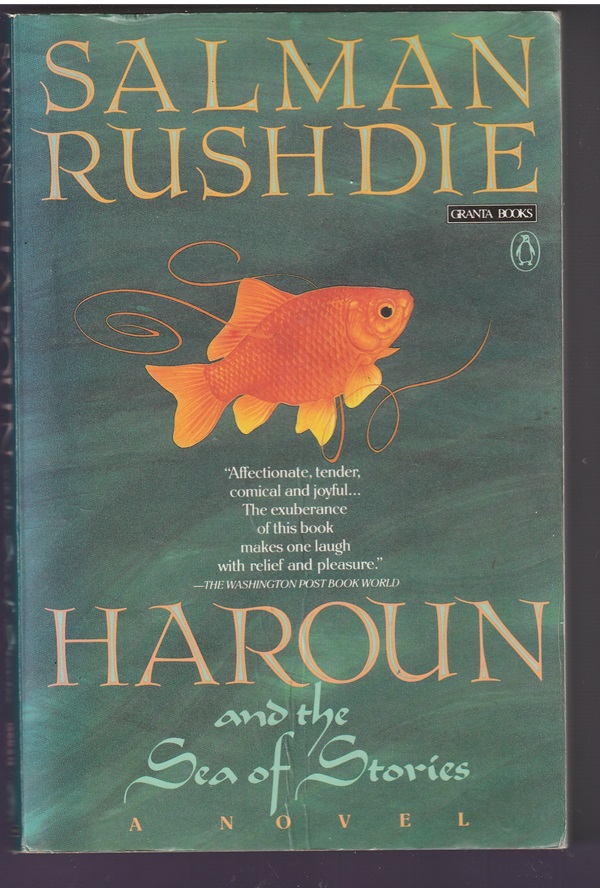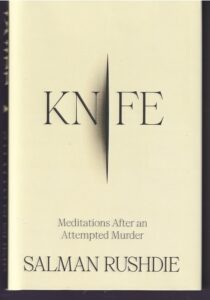Salman Rushdie’s 1990 novel Haroun and the Sea of Stories is joyous, inventive, delightful, funny, fun, enticing, stimulating, dazzling and playful.
It opens with a sentence about “a sad city, the saddest of cities, a city so ruinously sad that it had forgotten its name.”
Which may seem like something of a downer, yet the sentence is so over-the-top in its emphasis on the sadness of this forgotten-name place that it’s funny. As are the sentences that follow, such as the one about the city being next to “a mournful sea full of glumfish,” so wretched to eat that they make people belch with melancholy. And this one:
In the north of the sad city stood mighty factories in which (so I’m told) sadness was actually manufactured, packaged and sent all over the world, which never seemed to get enough of it.
It’s a sad, sad, sad place — and, in the odd way of humor, Rushdie has employed it in a spirited beginning to his tale, setting the stage for the storytelling wonders to follow.
“What’s the point of it?”
Deep in this city, in “an old zone of ruined buildings that looked like broken hearts,” there lives a happy young fellow named Haroun.
He is the only son of the storyteller Rashid Khalifa “whose cheerfulness was famous throughout that unhappy metropolis, and whose never-ending stream of tall, short and winding tales had earned him not one but two nicknames.” Admirers called Rashid the Ocean of Notions. Envious rivals dubbed him the Shah of Blah.
Haroun grew up listening to his father’s quick laughter and his mother’s sweet singing. But, suddenly, something is wrong. Soraya, his mother, stops singing, and, soon enough, she has run off with Mr. Sengupta from upstairs, a “sticky-thin and whiny voiced and mingy” clerk, and has left a note to Rashid that his “brain is filled with make-believe” with “no room for facts.”
Rashid turns to Haroun perplexed: What can he do? Storytelling is the only work he knows. And then come the words that Haroun says and immediately wants to take back:
“What’s the point of it? What’s the use of stories that aren’t even true?”
And Rushdie’s novel is off and running.

The Ocean of the Stream of Stories
Haroun’s complaint ruins Rashid’s confidence and dries up his inspiration and leaves him high and dry and sets off a train of incidents in which the son and father, together and then separately and then together again, try to reverse the damage.
It is quickly apparent that, to do so, Haroun and Rashid will have to reverse the much greater damage that is being done to the novel’s fictional Earth by an evil mastermind called Khattam-Shad (who bears a great resemblance to the whiny Mr. Sengupta).
Khattam-Shad is one of a multitude of puns and word plays with which Rushdie fills Haroun and the Sea of Stories. A short glossary in the back of the book explains that, in Hindustani, it means “completely finished” and “over and done with.” Like the end of a story you never want to end. Like death.
And that’s what Khattam-Shad wants to do with the Ocean of the Stream of Stories — to pump enough pollution into the water so that the colorful strands and currents of stories, going all the way back to the original source of stories, will turn dark and viscous and unable to brighten anyone’s life, to “completely finish” stories.
“That malodorous mist”
Throughout his adventure, Haroun never loses his jollity. Despite his moment of heresy, he is a believer in stories, working to restore his father’s belief.
For instance, the two arrive at Dull Lake and find it covered with a Mist of Misery, stinking of sadness and gloom and uncomfortably hot. Haroun tells his father that this must be the Moody Land, the subject of one of Rashid’s favorite stories, a place where everything changes according to the moods of its people.
“In the Moody Land, the sun would shine all night if there were enough joyful people around, and it would go on shining until the endless summer got on their nerves; then an irritable night would fall, a night full of mutterings and discontent, in which the air felt too thick to breathe. And when people got angry the ground would shake; and when people got muddled or uncertain about things the Moody Land got confused as well — the outlines of its buildings and lamp-posts and motor-cars got smudgy…”
But Rashid say that, no, Moody Land is just a story. (That’s how bad his loss of confidence has gotten, and his loss of belief in stories.)
To which the son tells the father to think only happy thoughts, and — voila! — “that malodorous mist tore apart like the shreds of an old shirt and drifted away on a cool night breeze.”
“The Arch-Enemy of all Stories”
As the adventure develops, it becomes clear that the many stories that Rashid used to tell have a deep connection to a fantastic world on the Earth’s second Moon.
That’s where the Ocean of the Stream of Stories is located.
And it’s where, on the perpetually bright side of the moon, Gup City (a kind of Emerald City) can be found, with its Water Genies and telepathic mechanical birds, among a wild array of strange and oddly attractive creatures, as well as a government featuring a king, a crown prince and a comptroller named the Walrus, whose full name is I.M.D. Walrus. Two of Haroun’s closest companions on his adventure are Iff, a Water Genie, and Butt, a telepathic mechanical bird.
The second moon is also where, on the perpetually dark side, the Land of Chup is under the power of Khattam-Shad and his strict orders for a way of life based on darkness and silence, as Iff explains:
“He is the Arch-Enemy of all Stories, even of Language itself. He is the Prince of Silence and the Foe of Speech.”
“Sew their lips together”
Khattam-Shad is the Cultmaster for the Mystery of Bezaban, a Cult of Dumbness or Muteness, based on Bezaban, a stone idol with no tongue, as Rashid tells Haroun:
“In the old days the Cultmaster, Khattam-Shad, preached hatred only towards stories and fancies and dreams; but now he has become more severe, and opposes Speech for any reason at all.”
As a result, the schools and law-courts and theaters have all had to close because of the Silence Laws.
“And I heard it said that some wild devotees of the Mystery work themselves up into great frenzies and sew their lips together with stout twine; so they die slowly of hunger and thirst, sacrificing themselves for the love of Bezaban.”
“The rudest, most contemptible word”
It’s a battle between light and darkness, between stories and silence.
Near the end of the adventure, Haroun is captured, coming face to face with Khattam-Shad:
“What brought you here, eh?” he asked in his dull, dull voice. “Stories, I suppose.” He said the word “stories” as if it were the rudest, most contemptible word in the language.
“Well, look where stories have landed you now. You follow me?…You’d have done better to stick to Facts, but you were stuffed with stories. You’d have done better to have stayed at home, but up you came. Stories make trouble. An Ocean of Stories is an Ocean of Trouble. Answer me this: what’s the use of stories that aren’t even true?”
The Satanic Verses
Haroun and the Sea of Stories is written in the light-hearted style of a fable, and, like many fables, it has been described as a book for children. In fact, it won the Writers Guild of Great Britain Award in that category in 1991.
It is, however, the sort of children’s book that can be enjoyed by children but is aimed most directly at adults. Haroun and the Sea of Stories is an allegory on human society and on the clash of priorities in human life.
And in Rushdie’s life, as well.
In September, 1988, Rushdie published The Satanic Verses, a novel that used humor and magical realism to look at modern life as well as the beginnings of Islam, particularly the disputed verses of the Qur’an dealing with three pagan goddesses. Prominent fundamentalist Muslims denounced the book as blasphemy, and, in mid-February, 1989, the Ayatollah Ruhollah Khomeini, then Supreme Leader of Iran, issued a fatwa, calling for the death of Rushdie and his publishers.
Rushdie was living in hiding under armed guard, fearing for his life, when, in September, 1990, almost exactly two years after The Satanic Verses, he published Haroun and the Sea of Stories.
“The world, however, is not for Fun”
In response to the threat of violence against him, in response to the hate directed against him, Rushdie told a playful story, with a message of steel — that stories are what make life life.
“Why do you hate stories so much?” Haroun blurted, feeling stunned. “Stories are fun…”
“The world, however, is not for Fun,” Khattam-Shud replied. “The world is for Controlling…You world, my world, all worlds. They are there to be Ruled. And inside every single story, inside every Stream of the Ocean, there lies a world, a story-world, that I cannot Rule at all. That is the reason why.”
Stories are freedom. That’s the moral of the fable that Rushdie tells.
It was true in 1990 and it’s true today. It’s always been true.
Patrick T. Reardon
5.17.24
 Note: More than thirty years after the issuance of the fatwa, Rushdie was attacked as he was about to give a lecture at the Chautauqua Institution by a knife-wielding assailant who stabbed him 15 times leaving him near death. In April of this year, he published Knife: Meditations After an Attempted Murder about the attack and his recovery from the wounds.
Note: More than thirty years after the issuance of the fatwa, Rushdie was attacked as he was about to give a lecture at the Chautauqua Institution by a knife-wielding assailant who stabbed him 15 times leaving him near death. In April of this year, he published Knife: Meditations After an Attempted Murder about the attack and his recovery from the wounds.
Written by : Patrick T. Reardon
For more than three decades Patrick T. Reardon was an urban affairs writer, a feature writer, a columnist, and an editor for the Chicago Tribune. In 2000 he was one of a team of 50 staff members who won a Pulitzer Prize for explanatory reporting. Now a freelance writer and poet, he has contributed chapters to several books and is the author of Faith Stripped to Its Essence. His website is https://patricktreardon.com/.
